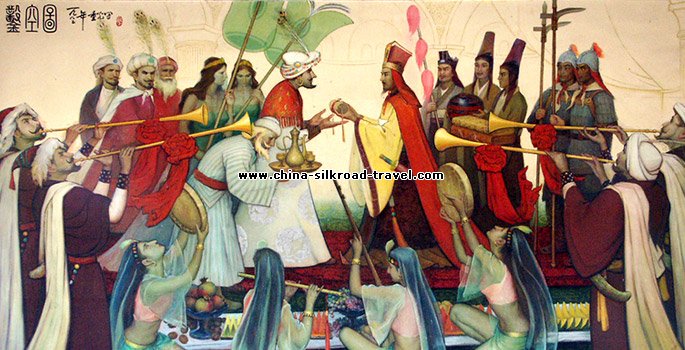Westward Dissemination of Sericulture and Silk Weaving Techn

Exchanges and Contacts on the Silk Road
The opening and the prosperity of the Silk Road facilitated the gradual dissemination of advanced production technologies and ancient cultural of the Central Plains to countries in the Western Regions,and it further spread to Central Asia,Europe and Africa;It also enabled the introduction of western countries’precessing technologies,special products,as well as culture and arts to China by way of the Western Regions.
 Westward Dissemination of Sericulture and Silk Weaving Technology
Westward Dissemination of Sericulture and Silk Weaving Technology
Among the commodities to the West through the Silk Road, silk was naturally the mos famous item. In his book Buddhist Records of the Western World,Xuanzang recorded the following story about the dissemination of the sericulture technology:around the time 420-440 when the silk road was re-opened,king of Qusadanna Kingdom,located in present-day Khotan in Xinjiang,was so impressed by the elegance and beauty of silk from China. So he sent his envoy to the Central Plains and requested to buy silkworm eggs and mulberry seeds from the Han Chinese.The request was not only turned down,but also raised the alarm of the imperial court who strengthened its interrogation and examination of people cross the border or staying at the posthouse, in order to prevent the outflow of mulberry seeds and silkworm eggs.Later the Qusandanna king proposed marriage to a Han princess.When he came to receive his bride,he tipped her to bring silkworm eggs and mulberry seeds.The princess secretly hid some silkworm eggs in her hair and brought them to her new home.She also brought with her some women who had the skills of sericulture and silk weaving.When they arrived in Qusadanna,they built a “deer-shooting city”where they taught local women to grow mulberry trees and raise silkworm. Not long after,the county was full of mulberry trees.Sericulture and silk reeling were quickly popularized. According to archaeological findings ,remains of ancient mulberry trees have been unearthed both in the Lop Nur sand area and ruins of the ancient Shanshan Kingdom. It has been identified that this ancient mulberry trees were planted before the 4th century, which was just about the time when mulberry and silkworm allegedly spread to the West.
According the Roman historian Procopius,Chinese sericulture was introduced to the Eastern Roman Empire around 550.During the region of Emperor Justinian the Great,An Indian monk who had lived in China for many years came to Constantinople,capital city of Eastern Roman Empire. He told Justinian that he was an expert on sericulture and he cloud get silkworm eggs.After reaching some sort of agreement with the Roman Emperor,the monk returned to China.Two years later he brought some silkworm eggs hidden in a hollow cane.Finally the Romans were able to produce some raw silk by themselves.
In the 7th century,West Asia was occupied by the Arab Empire.In 751,a battle broke out between the Arab army and the Tang army led to General Gao Xianzhi in the Talas River area of present-day Kazakhstan. The Tang army was defeated.Some silk weaves and paper workers among Tang soldiers was captured. It is very possible that this was how Chinese silk weaving and papermaking technologies were disseminated to West Asia.In the 8th century sericulture and silk weaving workshops enjoyed rapid development in Est Asia. There emerged many cities engaged in trade such as silk reeling,textile,printing and embroidery.The Persian region became the second largest silk producing area in the world.next only to China. Persian silk products supplies not only markets in West Asia,but also the European market of the Mediterranean region. In the 9th century,the Arab Empire annexed Spain.So sericulture was introduced to Italy and in the 15th century to France.
Silk Road Travel Guide
Our Blog
- thesilkroadchina.com is Liar
- Silk Road Tours in 2020
- Silk Road Tour for Senior Citizens
- Silk Road Train Tours
- Silk Road Private Tour
- Silk Road Travel from Australia
- Silk Road Tour from Malaysia
- The First Skating Ceremony of Hemu ...
- Southern Xinjiang Travel Experience...
- Our Tour to Xinjiang Province II



